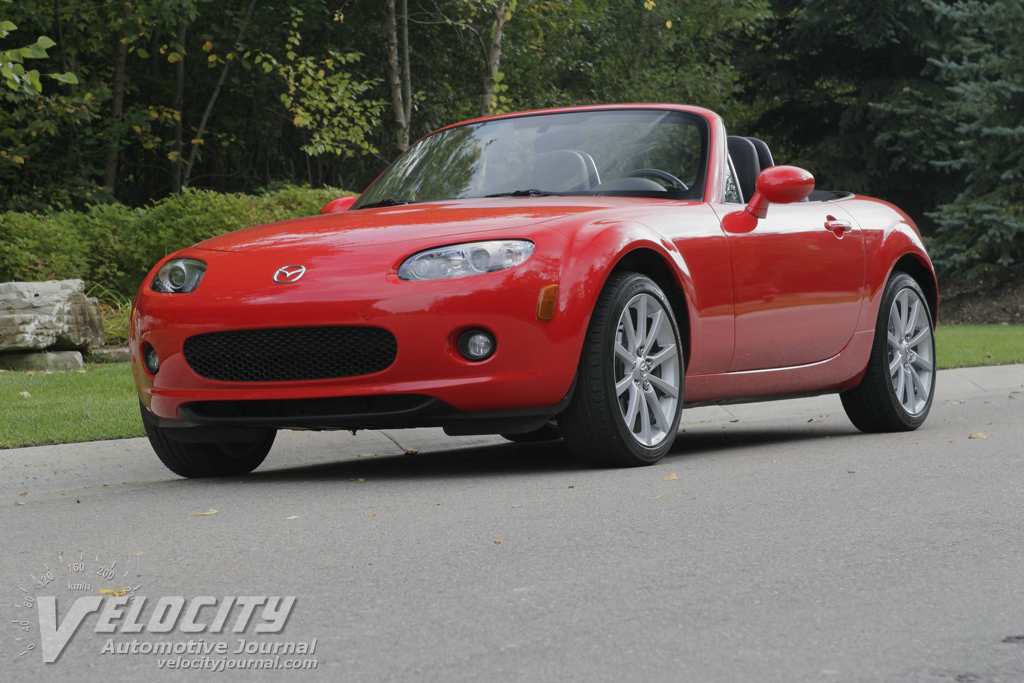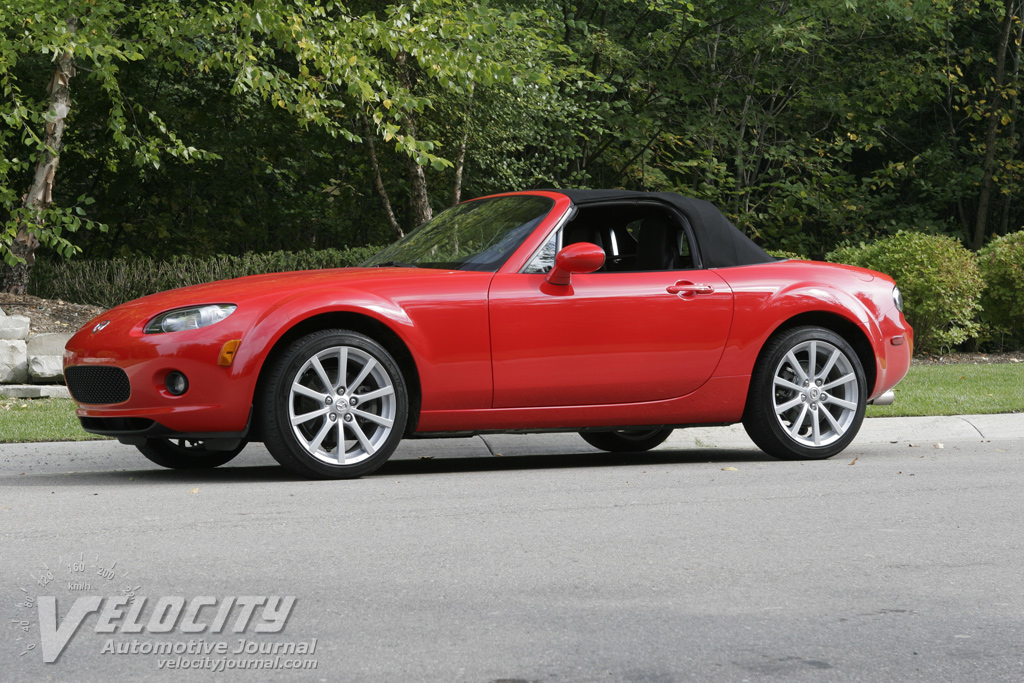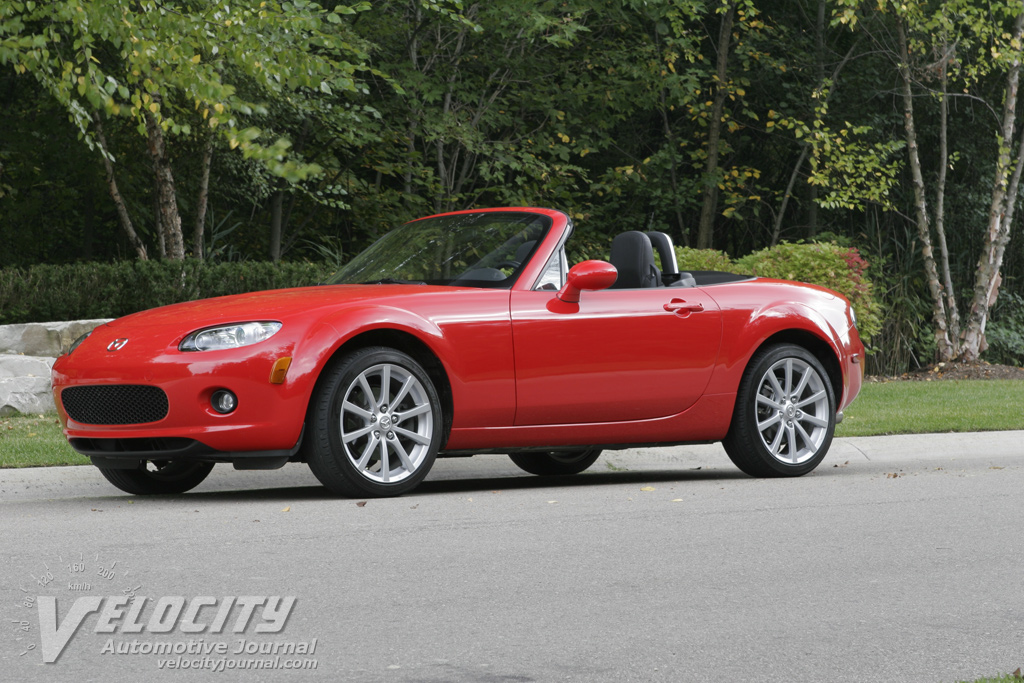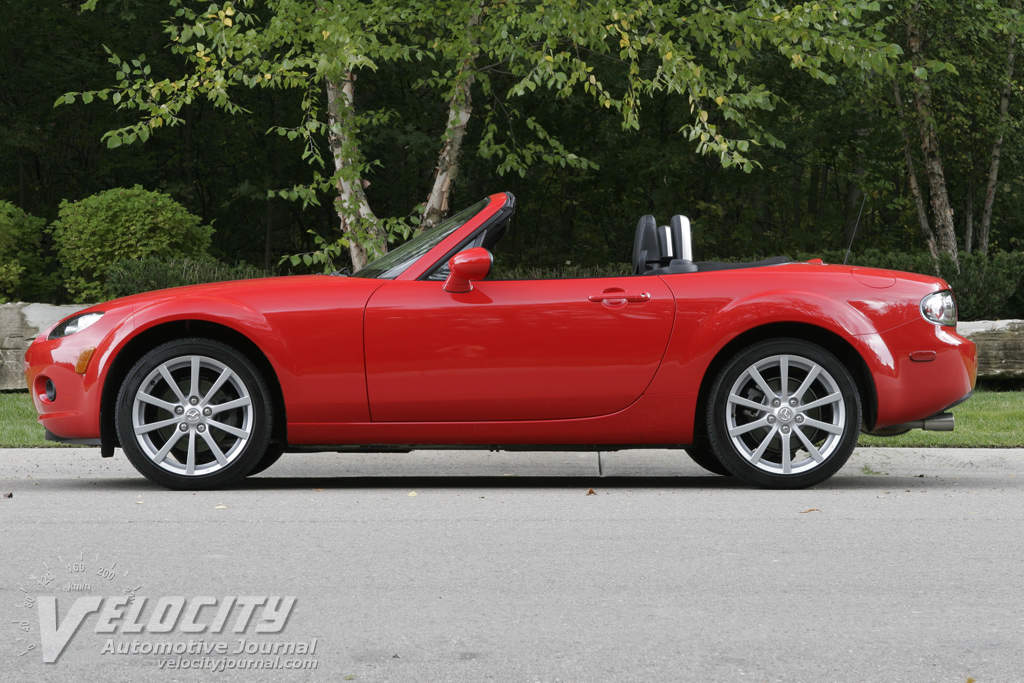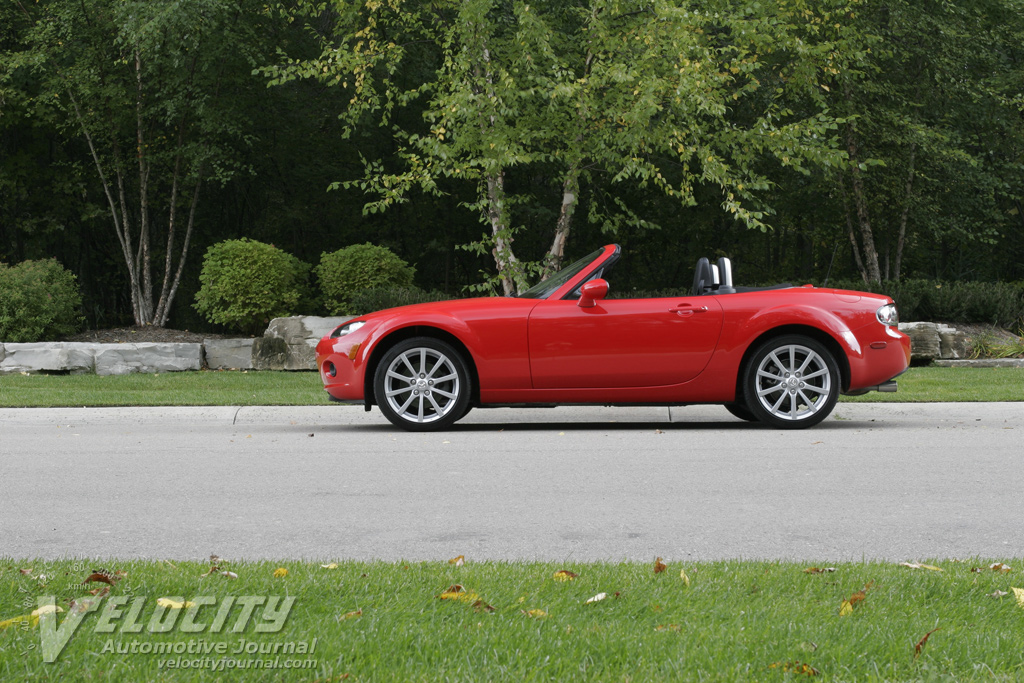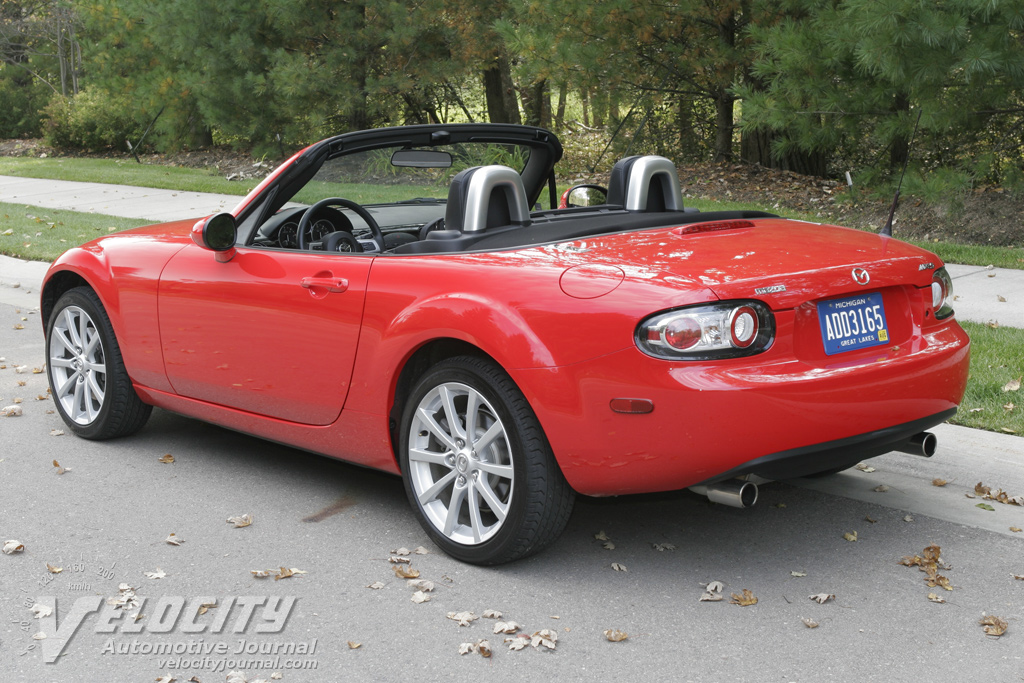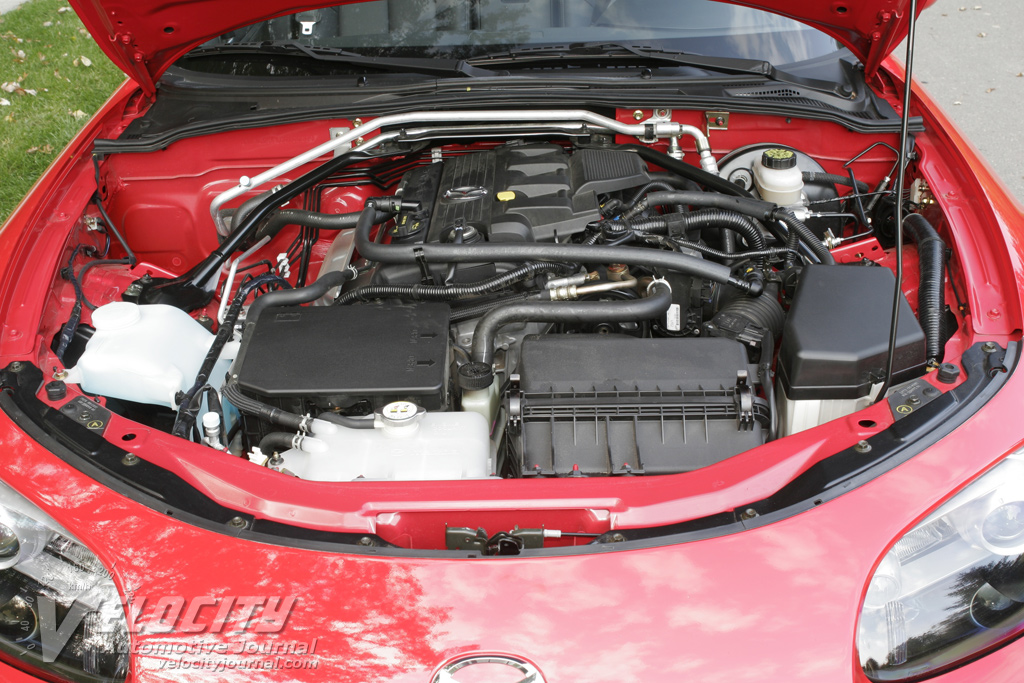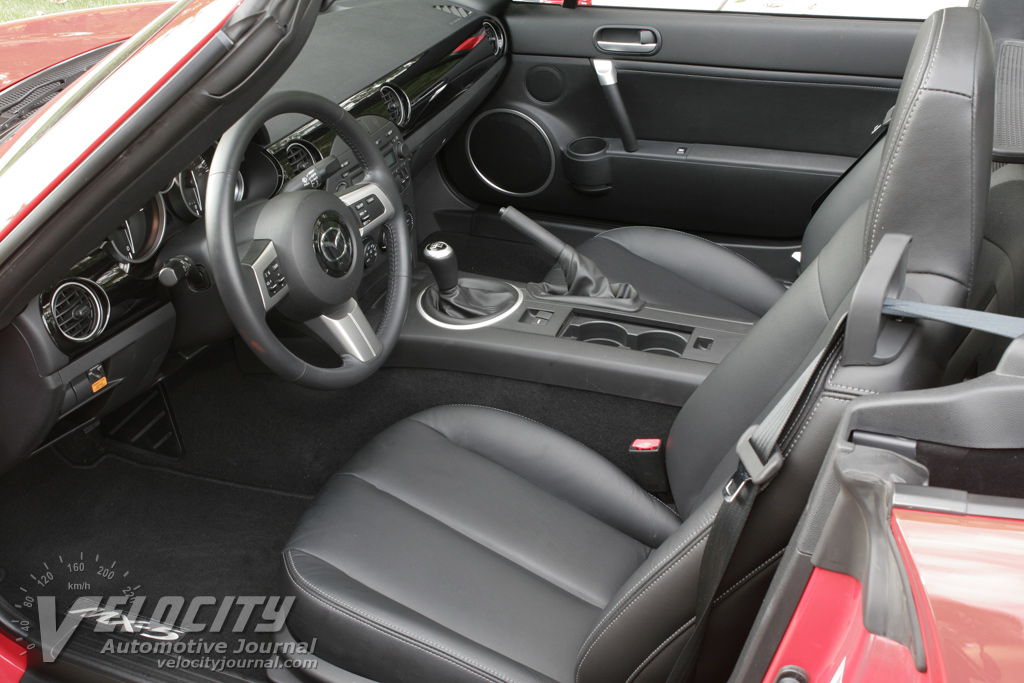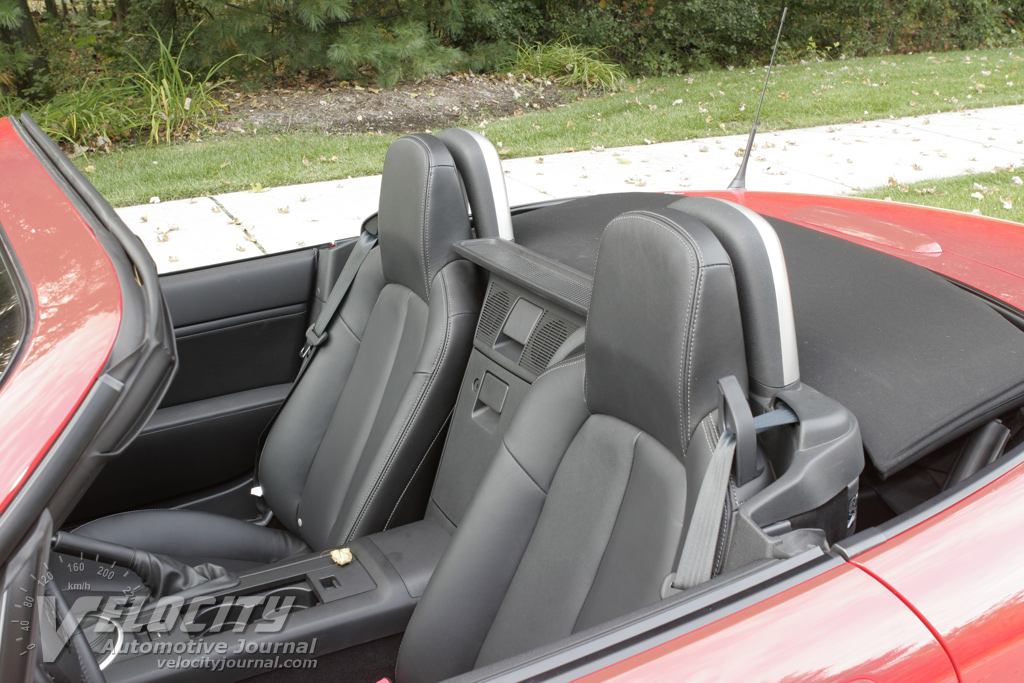2006 Mazda MX-5
10/12/2005
Shahed Hussain
The Mazda MX-5 has been the epitome of the affordable convertible sports car for more than 15 years. Although other manufacturers have tried repeatedly to emulate the MX-5's formula, no other car matches its unique combination of value, style, and handling. A loyal owner base ensures this Mazda's continued popularity. However, some may lament the passing of the "Miata" moniker as Mazda now simply calls it an MX-5.
For 2006, the MX-5 has been completely redesigned, yet it maintains the characteristics that make it so desirable. The exterior styling has been tightened up and has a more chiseled appearance. There is a passing resemblance to the RX-8 in the flared front wheel arches. Like the 2nd generation MX-5, exposed headlamps are retained, but dual projector beams lend a "shark-like" appearance to the new car. Small fog lights nestled low in the front fascia flank an oval honeycomb-pattern grille. Small aluminum roll bars fit directly behind the headrests. Optional 17-inch alloy wheels are mounted with 205/45-R17 Michelin Pilot performance tires. The rear fascia shows a close resemblance to the 2nd generation MX-5, with the familiar concentric lights integrated into the oval taillight bezels. Thankfully, no tacked-on spoiler mars the aluminum deck lid. Prominent dual exhaust tips exit from the dark gray lower fascia. Despite all the changes, the MX-5 is still instantly recognizable. Mazda has gone to great lengths to remove the "cute" aspects of the MX-5's styling and has largely succeeded.
A completely revamped interior incorporates attractive glossy black dash panel accents, flat aluminum trim on the steering wheel spokes, shifter knob and bezel, door handles, gauges, and vents. The upper dashboard and door panels are covered with durable pebble-grained hard black plastic. A cleverly designed button on the center of each vent turns airflow on or off. Three clearly marked HVAC knobs control ventilation in the cockpit, with special settings to optimize airflow direction for comfortable top-down cruising. Console-mounted dual cup holders are hidden by a sliding panel. The fuel filler release is hidden in a small compartment between the upper seatbacks. An optional Bose(R) CD audio system cranks out enough volume to be usable with the top down. As expected, the trunk is small, shallow, and is best suited for soft luggage. Pack lightly or don't bother.
Comfortable and supportive seats are especially important in a sports car. The MX-5 is above average in this regard, but there are a few shortcomings. The optional leather covered seats are well bolstered, but were only adjustable for reach and seatback rake. A height adjustment for the seat cushion would be appreciated, because some drivers may find their lower thighs positioned above the seat when driving. Also, passengers with wider posteriors will find that they are sitting above the lower seat bolsters, which could be uncomfortable for extended periods.
Lowering the manual fabric top is even simpler than before: press the release button to the right of the center-mounted latch, insert your hands into the two handles flanking the latch, and pull back. The top snaps into place as it retracts behind the seats. Raising the top is a little more involved, since the side windows should be first lowered slightly to ensure the top latch engages correctly. When the top is up, there is a large blind spot behind the driver, so merging and passing should be done with care. MX-5 fabric tops have always been unlined, and the latest car is no exception. Even though an unlined top is lighter and easy to manipulate, a fully lined top would reduce highway road and wind noise significantly.
Top down motoring in the MX-5 is quite comfortable up to about 50 mph. Wind noise is tolerable and the small wind blocker between the seats effectively cuts turbulence. If the ventilation system is set correctly, warm air rushes over the passengers' legs and shoulders. Cruising with the top retracted in 50-60 deg. F temperatures is no problem.
A new MZR 2.0L inline-4 cranks out a respectable 170-bhp (with a manual transmission), which finally moves the MX-5's acceleration from merely adequate to genuinely quick. The previous 1.8L engine is now only available in Europe. MX-5 owners now stand a chance of contending with V-6 midsize sedans and V-8 SUVs in a stoplight grand prix or highway merging and passing maneuvers. The 2.0L has much improved low-end torque, so the engine doesn't have to be revved above 3000 RPM for a quick launch.
As transmissions go, the optional 6-speed manual is a slick unit. This is a close-ratio gearbox that always has the right gear for corner carving. The shift gates are closely spaced, but there is just enough "notchiness" to ensure the correct gear is selected. A short 4.100:1 final drive ratio ensures lively acceleration even in 6th gear, which is usable at 50 mph. Conversely, the price of this performance is buzzy cruising at 80 mph, where the engine is spinning at 4,000 RPM.
No review of the MX-5 would be complete without a description of its superb handling. Mazda expended considerable engineering resources to ensure that the new MX-5 was only slightly heavier than the 2nd generation car. This is quite impressive, since the MX-5 now has side-impact airbags, a stiffer chassis, and a larger engine. Aluminum was used on the hood, deck lid, and chassis components to limit weight increases. The chassis rigidity improvements are the greatest contributor to the MX-5's much improved handling. Cowl shake, body shudder over bumps, and squeaks and rattles are nearly nonexistent. Granted, this was a low mileage MX-5, but it is an amazing improvement over the previous Miata.
As enthusiasts of this roadster know, it's not about maximum g-force, but the quick turn-in response and nimble handling that set the MX-5 apart from any other competitor. Crank the steering wheel, and the MX-5 obediently follows the intended arc. Grippy Michelin Pilot tires, combined with the optional limited-slip differential ensure superb cornering capabilities. The stiff chassis also improves the ride, since Mazda was able to tune springs and dampers for comfort, without compromising handling. Extra bottom-end torque from the 2.0L engine even allows some power-on oversteer, which is easily corrected with the nicely weighted steering. The short 91.7-inch wheelbase allows a curb-to-curb turning radius of only 15.4 ft., which means that a 3-point turn in most cars is often a simple full-lock U-turn in an MX-5. Freeway hop on some concrete surfaces is an unavoidable consequence of the compact wheelbase.
Is the new MX-5 the best one yet? Absolutely. Mazda has managed to improve the handling, performance, and styling for about the same price as the outgoing Miata. Even with the loss of the beloved Miata name, the MX-5 is a winner.

